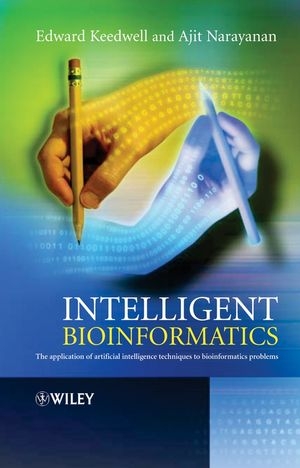
Intelligent Bioinformatics
John Wiley & Sons Inc (Verlag)
978-0-470-02175-0 (ISBN)
- Titel z.Zt. nicht lieferbar
- Versandkostenfrei innerhalb Deutschlands
- Auch auf Rechnung
- Verfügbarkeit in der Filiale vor Ort prüfen
- Artikel merken
Bioinformatics is contributing to some of the most important advances in medicine and biology. At the forefront of this exciting new subject are techniques known as artificial intelligence which are inspired by the way in which nature solves the problems it faces. This book provides a unique insight into the complex problems of bioinformatics and the innovative solutions which make up ‘intelligent bioinformatics’. Intelligent Bioinformatics requires only rudimentary knowledge of biology, bioinformatics or computer science and is aimed at interested readers regardless of discipline. Three introductory chapters on biology, bioinformatics and the complexities of search and optimisation equip the reader with the necessary knowledge to proceed through the remaining eight chapters, each of which is dedicated to an intelligent technique in bioinformatics.
The book also contains many links to software and information available on the internet, in academic journals and beyond, making it an indispensable reference for the 'intelligent bioinformatician'.
Intelligent Bioinformatics will appeal to all postgraduate students and researchers in bioinformatics and genomics as well as to computer scientists interested in these disciplines, and all natural scientists with large data sets to analyse.
Edward Keedwell is an Associate Professor in Computer Science. He joined the Computer Science discipline in 2006 having previously been a Research Fellow in the Centre for Water Systems and was appointed as a lecturer in Computer Science in 2009. Ajit Narayanan is the inventor of FreeSpeech, a picture language with a deep grammatical structure. He's also the inventor of Avaz, India's first Augmentative and Alternative Communication device for children with disabilities.
Preface ix Acknowledgement xi
PART 1 INTRODUCTION 1
1 Introduction to the Basics of Molecular Biology 3
1.1 Basic cell architecture 3
1.2 The structure, content and scale of deoxyribonucleic acid (DNA) 4
1.3 History of the human genome 9
1.4 Genes and proteins 10
1.5 Current knowledge and the ‘central dogma’ 21
1.6 Why proteins are important 23
1.7 Gene and cell regulation 24
1.8 When cell regulation goes wrong 26
1.9 So, what is bioinformatics? 27
1.10 Summary of chapter 28
1.11 Further reading 29
2 Introduction to Problems and Challenges in Bioinformatics 31
2.1 Introduction 31
2.2 Genome 31
2.3 Transcriptome 40
2.4 Proteome 50
2.5 Interference technology, viruses and the immune system 57
2.6 Summary of chapter 63
2.7 Further reading 64
3 Introduction to Artificial Intelligence and Computer Science 65
3.1 Introduction to search 65
3.2 Search algorithms 66
3.3 Heuristic search methods 72
3.4 Optimal search strategies 76
3.5 Problems with search techniques 83
3.6 Complexity of search 84
3.7 Use of graphs in bioinformatics 86
3.8 Grammars, languages and automata 90
3.9 Classes of problems 96
3.10 Summary of chapter 98
3.11 Further reading 99
PART 2 CURRENT TECHNIQUES 101
4 Probabilistic Approaches 103
4.1 Introduction to probability 103
4.2 Bayes’ Theorem 105
4.3 Bayesian networks 111
4.4 Markov networks 116
4.5 Summary of chapter 125
4.6 References 126
5 Nearest Neighbour and Clustering Approaches 127
5.1 Introduction 127
5.2 Nearest neighbour method 130
5.3 Nearest neighbour approach for secondary structure protein folding prediction 132
5.4 Clustering 135
5.5 Advanced clustering techniques 138
5.6 Application guidelines 144
5.7 Summary of chapter 145
5.8 References 146
6 Identification (Decision) Trees 147
6.1 Method 147
6.2 Gain criterion 152
6.3 Over fitting and pruning 157
6.4 Application guidelines 160
6.5 Bioinformatics applications 163
6.6 Background 169
6.7 Summary of chapter 170
6.8 References 170
7 Neural Networks 173
7.1 Method 173
7.2 Application guidelines 185
7.3 Bioinformatics applications 187
7.4 Background 192
7.5 Summary of chapter 193
7.6 References 193
8 Genetic Algorithms 195
8.1 Single-objective genetic algorithms – method 195
8.2 Single-objective genetic algorithms – example 202
8.3 Multi-objective genetic algorithms – method 205
8.4 Application guidelines 207
8.5 Genetic algorithms – bioinformatics applications 210
8.6 Summary of chapter 217
8.7 References and further reading 217
PART 3 FUTURE TECHNIQUES 219
9 Genetic Programming 221
9.1 Method 221
9.2 Application guidelines 230
9.3 Bioinformatics applications 232
9.4 Background 236
9.5 Summary of chapter 236
9.6 References 237
10 Cellular Automata 239
10.1 Method 239
10.2 Application guidelines 245
10.3 Bioinformatics applications 247
10.4 Background 251
10.5 Summary of chapter 252
10.6 References and further reading 252
11 Hybrid Methods 255
11.1 Method 255
11.2 Neural-genetic algorithm for analysing gene expression data 256
11.3 Genetic algorithm and k nearest neighbour hybrid for biochemistry solvation 262
11.4 Genetic programming neural networks for determining gene – gene interactions in epidemiology 265
11.5 Application guidelines 268
11.6 Conclusions 268
11.7 Summary of chapter 269
11.8 References and further reading 269
Index 271
| Erscheint lt. Verlag | 27.5.2005 |
|---|---|
| Verlagsort | New York |
| Sprache | englisch |
| Maße | 158 x 236 mm |
| Gewicht | 531 g |
| Themenwelt | Informatik ► Theorie / Studium ► Künstliche Intelligenz / Robotik |
| Naturwissenschaften ► Biologie | |
| ISBN-10 | 0-470-02175-6 / 0470021756 |
| ISBN-13 | 978-0-470-02175-0 / 9780470021750 |
| Zustand | Neuware |
| Haben Sie eine Frage zum Produkt? |
aus dem Bereich


